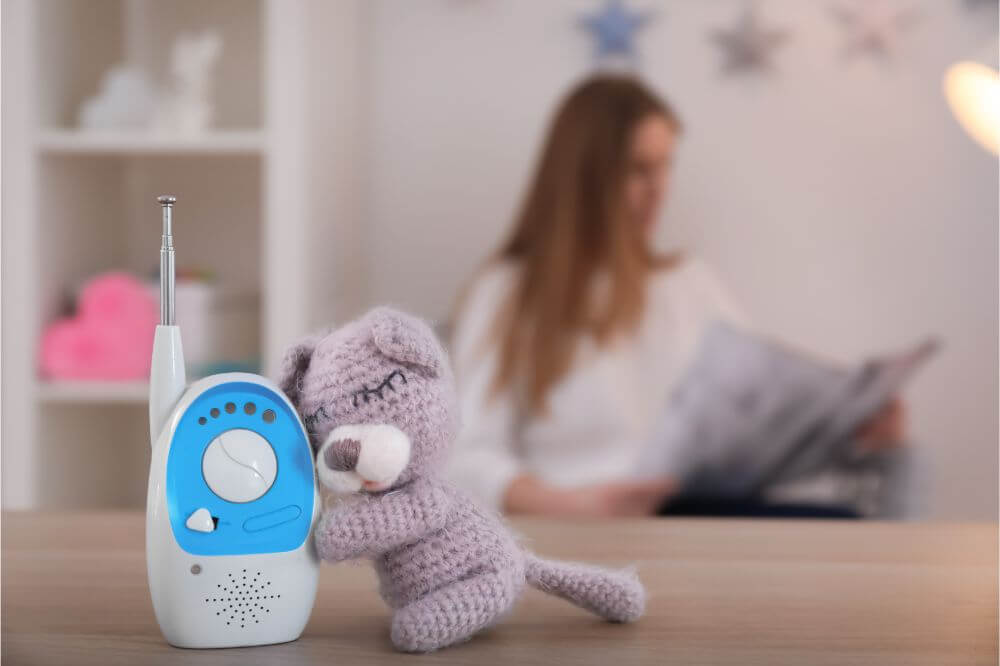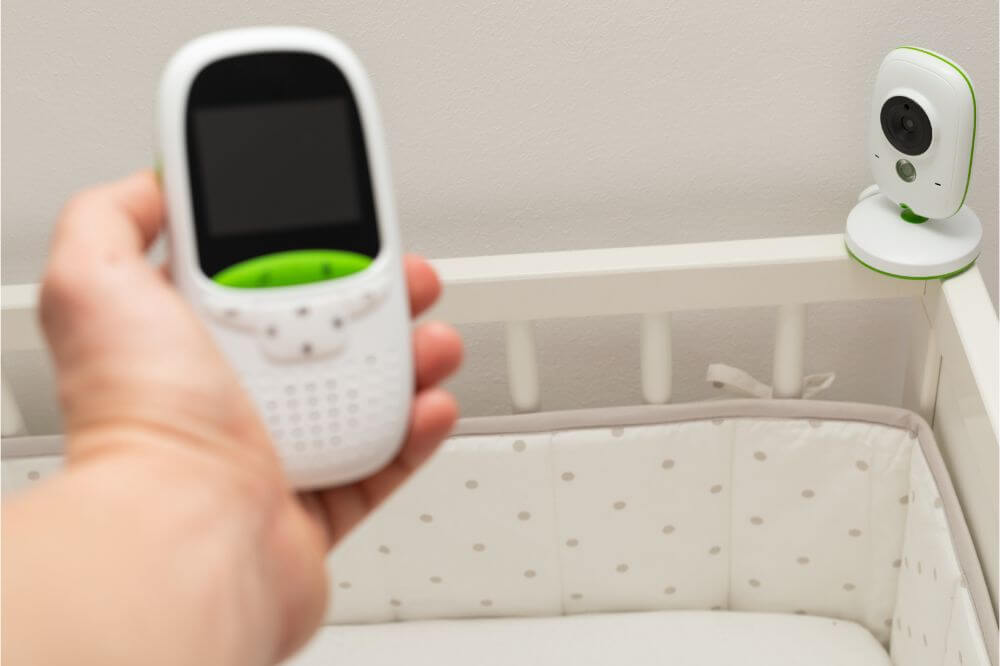As you set up your baby’s nursery, you might wonder, “How close should a baby monitor be?” Consider factors like sound clarity, viewing angles, and connectivity for optimal performance and safety.
This guide discusses proper baby monitor placement for various types and shares tips to maximize their potential.
Factors Affecting Baby Monitor Placement
When deciding how close the baby monitor should be, various factors may affect its placement. First, consider the size of the room and the layout; a larger room will require a wider viewing angle, while a smaller room may need a more targeted view.
Hearing your baby’s movements and cries clearly also plays a crucial role. Each monitor type operates differently, and the technology will influence the range and signal required for optimal performance.
Another essential aspect is your baby’s safety. Ensure there are no loose cords that could become a strangulation hazard or other potential dangers.
Lastly, consider the convenience factor – placing the monitor in a spot where you can easily access and adjust it as needed will make your life much easier.
Recommended Distance: Safe and Efficient
When considering how close the baby monitor should be, it’s essential to balance safety and efficiency.
A general rule of thumb is to place the monitor at least three feet away from the crib or sleeping area. This distance ensures the monitor is close enough to provide clear audio and video while preventing potential safety hazards, such as strangulation from cords or electric shock.
Additionally, ensure the monitor is placed on a stable surface or securely mounted on the wall to prevent it from falling or being knocked over.
Consider performing a test run to check the performance of your monitor at the recommended distance, making any necessary adjustments to guarantee optimal monitoring and peace of mind.
Audio Baby Monitors: Sound Clarity and Minimizing Interference
For audio baby monitors, the priority is achieving clear sound and minimizing interference from other electronic devices. Place the monitor at least three feet from the crib, ensuring no obstructions between the transmitter and receiver.
You may need to experiment with different locations to find the optimal position for the best sound quality.
If your baby monitor operates on a frequency used by other wireless devices, like cordless phones or Wi-Fi routers, try moving these devices to another room or switch your baby monitor to a different frequency, if possible. This will help reduce sound distortion and ensure clear communication between you and your little one.

Video Baby Monitors: Proper Viewing Angles and Image Quality
For parents opting for video baby monitors, proper placement is crucial for clear visuals and effective monitoring. Start by mounting the camera at a suitable height (ideally 6-8 feet from the ground) on a wall or shelf opposite your baby’s crib.
Ensure it is not within reach of your little one to prevent any safety hazards. Tilt and pan features can help you achieve the best angle to cover a wider room area, allowing you to watch your baby irrespective of their movement.
Ideally, position the camera to capture your baby’s crib without being too close to avoid pixelated images or too far, resulting in low-resolution footage.
Lastly, ensure enough lighting for clear visuals while being mindful not to disrupt your baby’s sleep pattern.
Wi-Fi and Smart Baby Monitors: Optimal Connectivity and Data Privacy
The proper placement is essential for ensuring optimal connectivity and data privacy in the case of Wi-Fi and smart baby monitors.
Typically, placing these monitors closer to your home’s router is recommended to maintain a strong and stable internet connection. However, you should also ensure monitors are located in a secure area of your nursery, away from potential access by unauthorized individuals.
Additionally, always use strong, unique passwords for your devices, and routinely update your monitor’s firmware to protect your baby’s privacy and enjoy a seamless monitoring experience.
Safety Considerations: Preventing Strangulation and Electric Hazards
Remembering safety when deciding on a baby monitor’s location is crucial. To prevent strangulation, ensure cords are at least 3 feet away from your baby’s crib, cot, or play area.
Keep the baby monitor and its electrical connections out of reach and securely fastened to avoid potential electric hazards. Always follow installation instructions and recommendations provided by the baby monitor manufacturer to maintain a safe environment for your little one.
Maximizing Baby Monitor Features: Additional Tips and Tricks
Consider some additional tips and tricks to make the most of your baby monitor. Keep the monitor’s sensors clean to ensure accurate readings, and regularly update your device’s firmware for optimal performance.
Be mindful of the room’s temperature, as extreme fluctuations may affect the device’s functionality.
Finally, familiarize yourself with your baby monitor’s settings and features, such as two-way communication and customizable alerts, to create a personalized and practical experience for you and your baby.
Conclusion
Finding the perfect spot for your baby monitor is crucial for ensuring your peace of mind. By considering factors like sound clarity, viewing angles, connectivity, and safety hazards, you can create a safe and efficient monitoring system for your little one.
Proper placement will help you closely watch your baby and provide the necessary reassurance during those precious early months.

